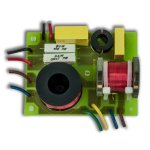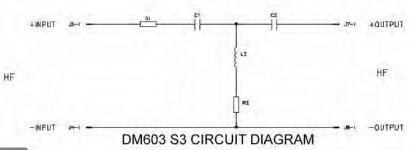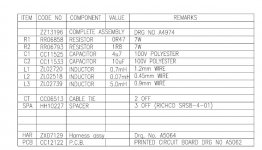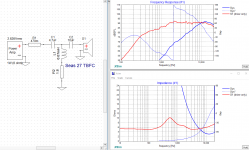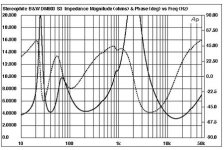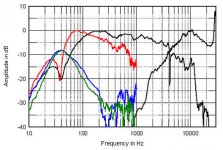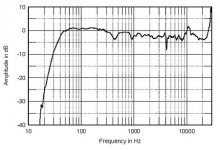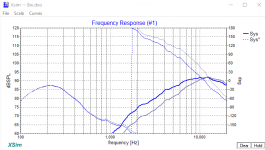I`m listening to a pair of these British floorstanders and love them for the most part, Huge bang for the buck speakers, however, I find they lack sparkle in the top end. The tweeters are undamaged and sound fine and equal so Im guessing a tweak to the crossover ie. better quality capacitors and resistors might be in order.
I wouldnt want to mess with any crossover points but a little more tweeter drive would be a good thing.
Which resistor(s) in the high pass filter is responsible for attenuating the tweeter?
Thanks in advance 🙂
I wouldnt want to mess with any crossover points but a little more tweeter drive would be a good thing.
Which resistor(s) in the high pass filter is responsible for attenuating the tweeter?
Thanks in advance 🙂
Attachments
The top one does this. You may not get a gradual rise by changing this resistor but it will increase the output of the tweeter.
The top one does this. You may not get a gradual rise by changing this resistor but it will increase the output of the tweeter.
What kind of increase in level would you expect if you were to just shunt that
.47 ohm resistor?
Not much. You will probably notice the difference.
I guess what you want is a smooth rise, like you might get from a receiver with a treble control.
I guess what you want is a smooth rise, like you might get from a receiver with a treble control.
Not much. You will probably notice the difference.
I guess what you want is a smooth rise, like you might get from a receiver with a treble control.
In my original post I should have only said I`d like some more tweeter drive and not more sparkle, those are two different things.
I realize those speakers are built to a certain price point, those caps and resistors appear to be cheap Bennics, surely they arent helping matters. Perhaps all that is really needed are better components?
Component quality has only a secondary effect, it is typically superficial.
Is it possible these were designed to have a more natural sounding tone? I would definitely try shunting the resistor but the sensitivity of the tweeter is limited. Your other options will be lifting the lower treble or reducing the woofer level.
Things you could try include increasing the value of R2 and shunting C2. These changes might create other issues but might tell you if you are on the right track with regards to levels, so if they work you might make other tweaks in the crossover as well.
Is it possible these were designed to have a more natural sounding tone? I would definitely try shunting the resistor but the sensitivity of the tweeter is limited. Your other options will be lifting the lower treble or reducing the woofer level.
Things you could try include increasing the value of R2 and shunting C2. These changes might create other issues but might tell you if you are on the right track with regards to levels, so if they work you might make other tweaks in the crossover as well.
I had the opportunity to measure one of my acquaintance's B&W 603S3. I found that around 7-10kHz the tweeter and the midwoofer is out of phase to the degree where their combined response is lower in level than the tweeter alone. This and the high xo point (4.5kHz measured) relative to midwoofer size (beaming) maybe the result of lack sparkle on top end. I don't think "better" quality parts remedy this problem.
Bypassing R1 results around +1dB tweeter level maybe it's worth a try because is a fully restorable action.
Bypassing R1 results around +1dB tweeter level maybe it's worth a try because is a fully restorable action.
Last edited:
Can you measure the frequency response of the speaker and the drivers with and without the crossover?
It doesn't look as if only resistor modifications would have solved the problem entirely. Fact is this is a high XO frequency and by making it lower might improve subjective performance. This means modifying first cap and shunt inductor.
Attachments
To Lojzek:
Can you give an explanation of the diagrams (what is measured)?
B&W DM603 S3 loudspeaker Measurements | Stereophile.com
To Lojzek:
Can you give an explanation of the diagrams (what is measured)?
Hallo fuerst, as deni already explained, the last two plots were taken from stereophile measurements and the first one is a simulation of mine under conditions as depicted. My sim shows what is generally to be expected of this XO circuit and while the FR does not track the original one, the impedance is reasonably close. Conclusion, a modification of a greater extent is realistic if one wanted a significant change in tweeter spl, in the range where it's likely to be perceived as beneficial. OP is free to draw his own conclusions and their significance.
Conclusion, a modification of a greater extent is realistic if one wanted a significant change in tweeter spl, in the range where it's likely to be perceived as beneficial. OP is free to draw his own conclusions and their significance.
A big thanks to all who have replied so far. If I interpret things correctly:
1- Replacing inferior components will yield minimum results
2- Shunting R1 will give a 1db increase in SPL
3- Due to the nature of the tweeters low sensitivity, it would be necessary to attenuate the Bass and Bass Mid drivers to reach my objective
Regarding the cancellation in the 7-10khz region mentioned here earlier and looking at the Stereophile measured frequency response with a deep and narrow notch at 4khz, how can something like that be addressed?
What effect would inverting the tweeters polarity have?
Attachments
It is *big* problem to change an existing speaker.
When you don´t know the technical details (TS parameters) of the driver units, then is nearly impossible to change the crossover.
When you don´t know the technical details (TS parameters) of the driver units, then is nearly impossible to change the crossover.
I tried inverting the tweeter polarity and the result is a deep null at xo point. So with normal polarity the drivers phase is match at that point, but the high xo point and the midwoofer shallow roll-off spoils the 7-10kHz region.
Otherwise if you have four amp channel you can bi-amp this speaker, one channel is bass-midbass the other channel is the tweeter and you can easily adjust the relative levels without modifying the crossover.
Otherwise if you have four amp channel you can bi-amp this speaker, one channel is bass-midbass the other channel is the tweeter and you can easily adjust the relative levels without modifying the crossover.
Last edited:
Regarding the cancellation in the 7-10khz region mentioned here earlier and looking at the Stereophile measured frequency response with a deep and narrow notch at 4khz, how can something like that be addressed?
Best route to deal with potential "deficiencies" is to modify midbass LP by increasing the electrical order and lowering the XO point by modifying tweeter HP. Simulation graph of the said Seas tweeter with B&W filter by increasing C1=4.7 to C1=10 uF produces this change. A 0.07 mH is very restricting also.
Attachments
I think what you're trying to say is your speakers sound "dull" even though the measurements look fine.In my original post I should have only said I`d like some more tweeter drive and not more sparkle, those are two different things.
If so, the crossover at 4kHz is the culprit because the 6.5" midwoofer is doing the lower treble. Lowering the crossover frequency to about 2.5kHz will make a huge difference but it will create other issues. It's not something that can be easily resolved.
Mike
I think what you're trying to say is your speakers sound "dull" even though the measurements look fine.
If so, the crossover at 4kHz is the culprit because the 6.5" midwoofer is doing the lower treble. Lowering the crossover frequency to about 2.5kHz will make a huge difference but it will create other issues. It's not something that can be easily resolved.
Mike
2.5khz would definitely take things into the right direction and I find 4khz a rather high crossover frequency but I`m unsure that tweeter can even handle anything lower than where its at.
I would change the steepness of the mid's high frequency drop off and leave the tweeter crossover as is. Also try different placement in the room (move further from the front wall, toe in, tilt upwards, etc.).
I would change the steepness of the mid's high frequency drop off and leave the tweeter crossover as is.
Can that be easily accomplished?
- Status
- Not open for further replies.
- Home
- Loudspeakers
- Multi-Way
- B&W 603S3 crossover
